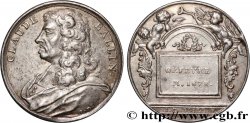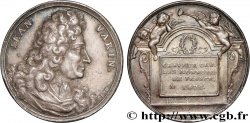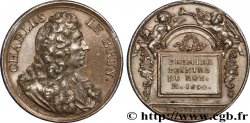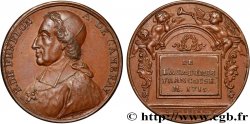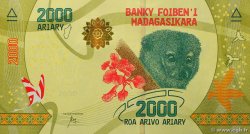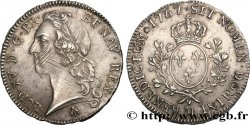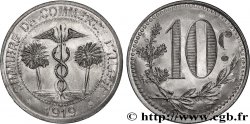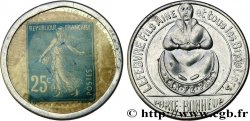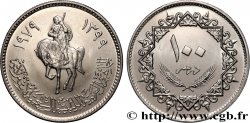fjt_072894 - DASSIER - LES HOMMES ILLUSTRES Jeton Ar 28, Samuel Bochart, né à Rouen 1667
无库存.
所有在网站上销售的产品 (2011)
价格 : 135.00 €
所有在网站上销售的产品 (2011)
价格 : 135.00 €
种类 Jeton Ar 28, Samuel Bochart, né à Rouen
日期: 1667
材质 silver
直径 28,5 mm
模子方针 12 h.
重量 10,23 g.
侧面 lisse
关于品相的说明
De petites marques de manipulation et une légère usure sur les reliefs. Très bel exemplaire
出版目录中的项代码 :
正面
正面的文字 SAMUEL - BOCHART..
正面的说明书 Buste à gauche de Samuel Bochart, en bas à sa droite signature I.D..
背面
背面的文字 PROFESSEUR/ ES LANGUES/ ORIENTALES/ M. 1667..
背面的说明书 Inscription en quatre lignes sur son tombeau surmonté de deux angelots ; à l’exergue signature I. DASSIER. F..
评论
Samuel Bochart (1599-1667) est né à Rouen et s’installe à Caen dès 1628 après avoir fait de brillantes études de théologie. Il parle dix-sept langues en dehors du français et publie en 1646 la Geographia Sacra qui lui vaut une grande renommée et une invitation à la cour de la reine Christine de Suède. Pasteur protestant, il représente les protestants en 1659 au Synode de Loudun. Il meurt à l’Académie de Caen dans les bras de son ami Pierre Daniel Huet avec lequel il discutait sur le transsubstantiation. Jean Dassier est un médailleur suisse né à Genève en 1676, fils d’un graveur de la Monnaie de Genève. Il étudie aussi à Paris avec Mauger et Röettiers. De retour à Genève, il est graveur puis graveur en chef après le décès de son père et ce jusqu’en 1763. Il est l’auteur de plusieurs séries sur les grands personnages de la réforme, les théologiens genevois, les rois et les reines d’Angleterre, l’histoire romaine, l’histoire de Genève, les hommes illustres, les rois de France et les grands personnages français. La série sur les hommes célèbres compte 67 médailles dessinées par D’Arlau, dont la liste figure dans le Mercure de France d’avril 1723, p. 300 et dans un ouvrage imprimé en 1723 à Paris.
Samuel Bochart (1599-1667) was born in Rouen and moved to Caen in 1628 after completing brilliant theological studies.. He spoke seventeen languages apart from French and in 1646 published the Geographia Sacra which earned him great fame and an invitation to the court of Queen Christina of Sweden.. A Protestant pastor, he represented the Protestants in 1659 at the Synod of Loudun. He died at the Academy of Caen in the arms of his friend Pierre Daniel Huet with whom he was discussing transubstantiation.. Jean Dassier was a Swiss medalist born in Geneva in 1676, son of an engraver at the Geneva Mint.. He also studied in Paris with Mauger and Röettiers. Back in Geneva, he was an engraver and then chief engraver after his father's death, until 1763.. He is the author of several series on the great figures of the Reformation, Genevan theologians, the kings and queens of England, Roman history, the history of Geneva, illustrious men, the kings of France and great French figures.. The series on famous men includes 67 medals designed by D'Arlau, the list of which appears in the Mercure de France of April 1723, p.. 300 and in a work printed in 1723 in Paris
Samuel Bochart (1599-1667) was born in Rouen and moved to Caen in 1628 after completing brilliant theological studies.. He spoke seventeen languages apart from French and in 1646 published the Geographia Sacra which earned him great fame and an invitation to the court of Queen Christina of Sweden.. A Protestant pastor, he represented the Protestants in 1659 at the Synod of Loudun. He died at the Academy of Caen in the arms of his friend Pierre Daniel Huet with whom he was discussing transubstantiation.. Jean Dassier was a Swiss medalist born in Geneva in 1676, son of an engraver at the Geneva Mint.. He also studied in Paris with Mauger and Röettiers. Back in Geneva, he was an engraver and then chief engraver after his father's death, until 1763.. He is the author of several series on the great figures of the Reformation, Genevan theologians, the kings and queens of England, Roman history, the history of Geneva, illustrious men, the kings of France and great French figures.. The series on famous men includes 67 medals designed by D'Arlau, the list of which appears in the Mercure de France of April 1723, p.. 300 and in a work printed in 1723 in Paris








 对产品描述纠错
对产品描述纠错 打印
打印 分享我的选择
分享我的选择 提问
提问 Consign / sell
Consign / sell
 产品介绍
产品介绍